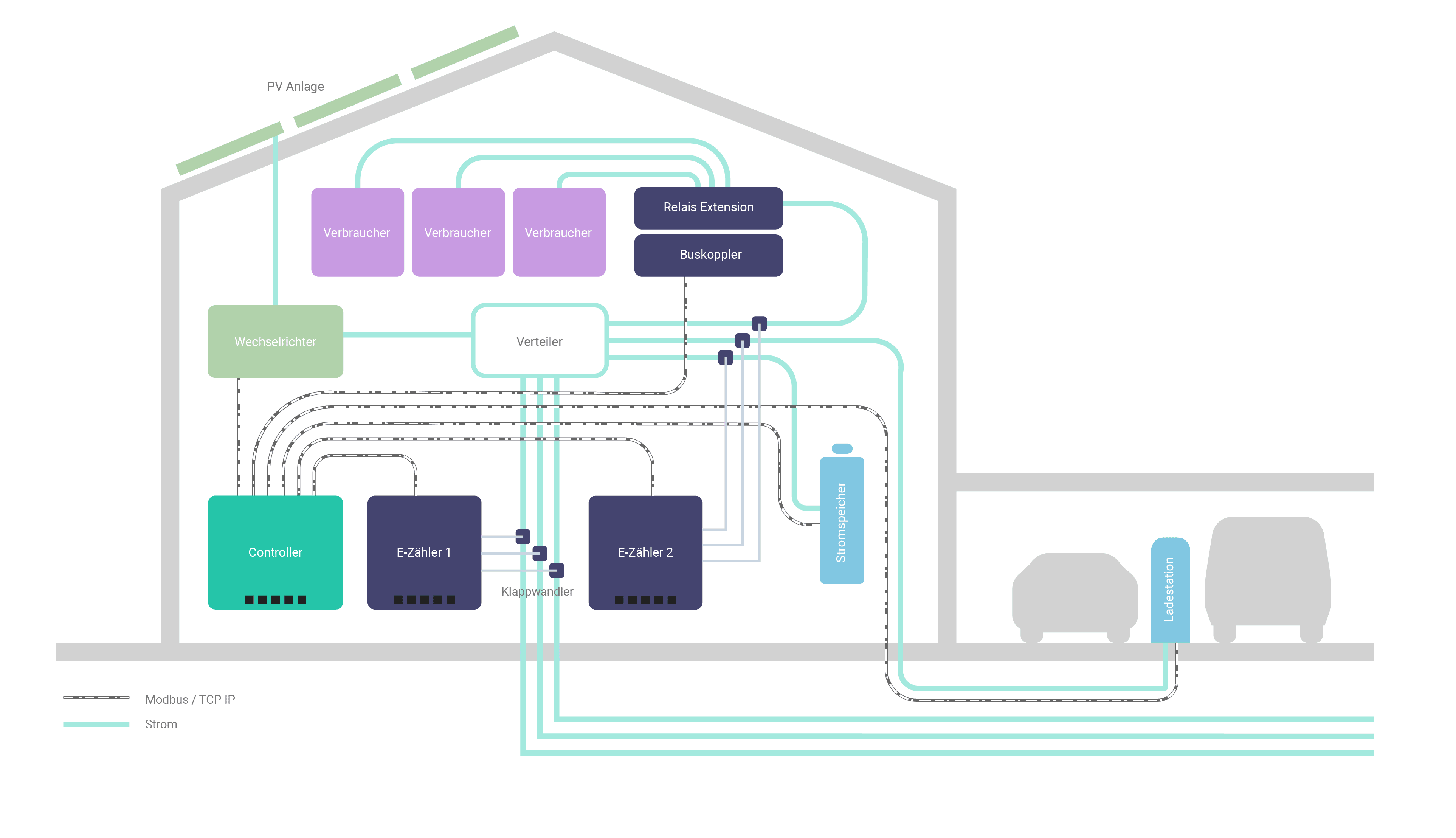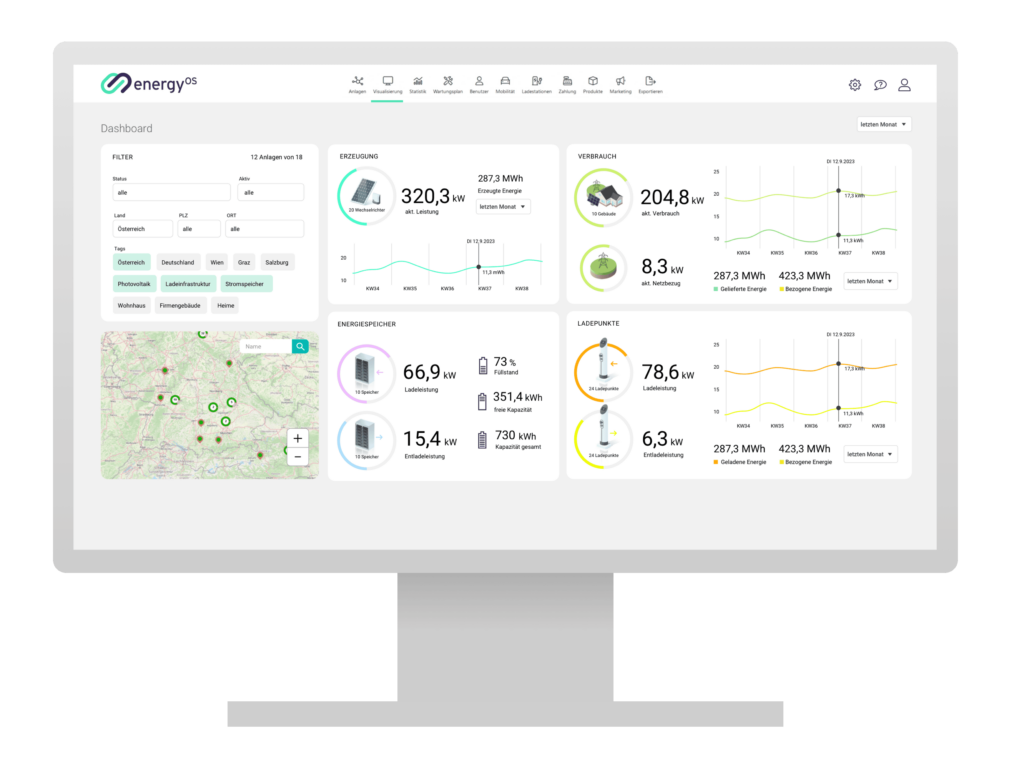
What is energy management and monitoring?
Regardless of whether it is a residential building, shopping center, hotel, supermarket or industrial plant, energy management is used to identify potential savings and optimize consumption. In the first step, energy flow data is recorded and analyzed by means of monitoring. In the second step, ideas for improvement are developed, evaluated for cost-effectiveness and then implemented using a control system.
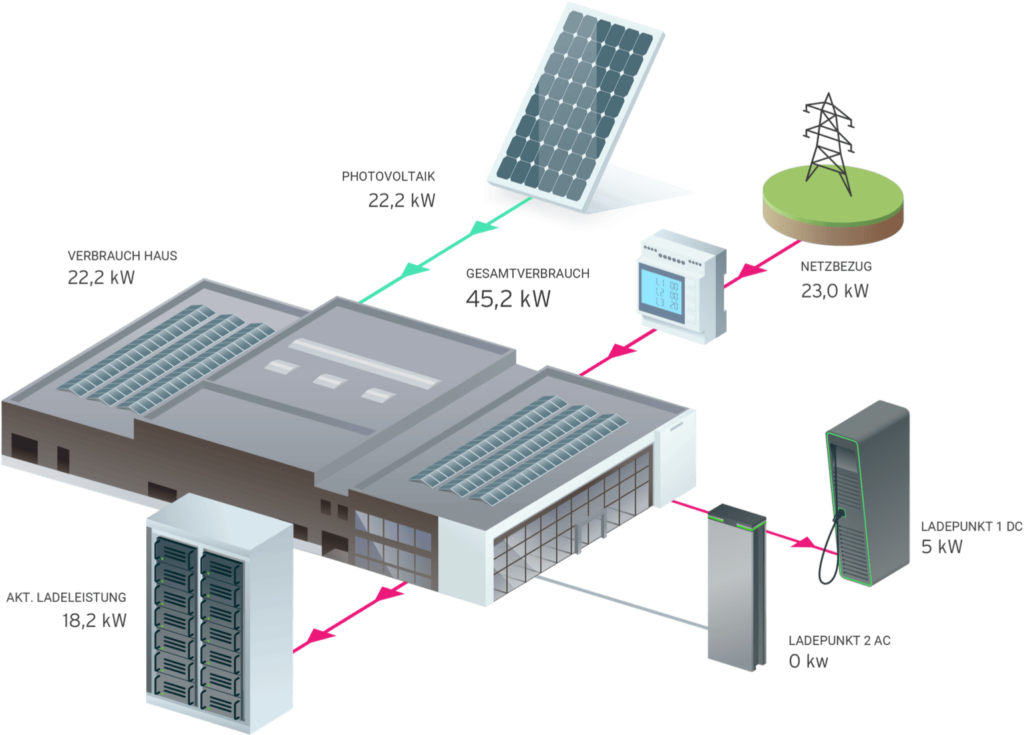
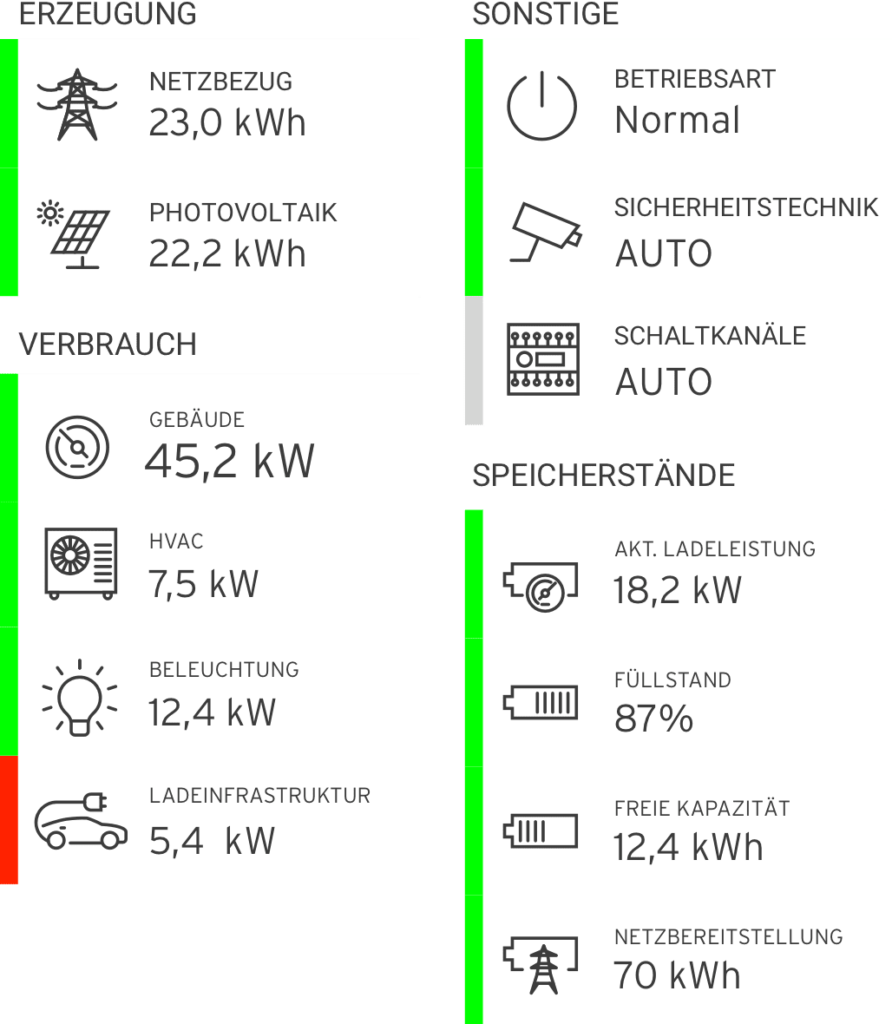
Energy management and consumption optimization
All consumers, generators and storage units are connected to a uniform system that monitors and controls the system, regardless of the manufacturer and model. The entire system is clearly visualized using an intuitive user interface, including all values and energy flows, and connected to other systems and applications such as the spot and balancing energy market, peak load reduction or storage management. The recorded data is also processed further to optimize consumption.
Connection to chargeOS
The connection to chargeOS gives you centralized access to the complete energy management of your system via a common platform. Both chargeOS and energyOS are part of our proprietary software ecosystem and can therefore be used seamlessly via a shared dashboard. This ensures smooth integration of the functions.
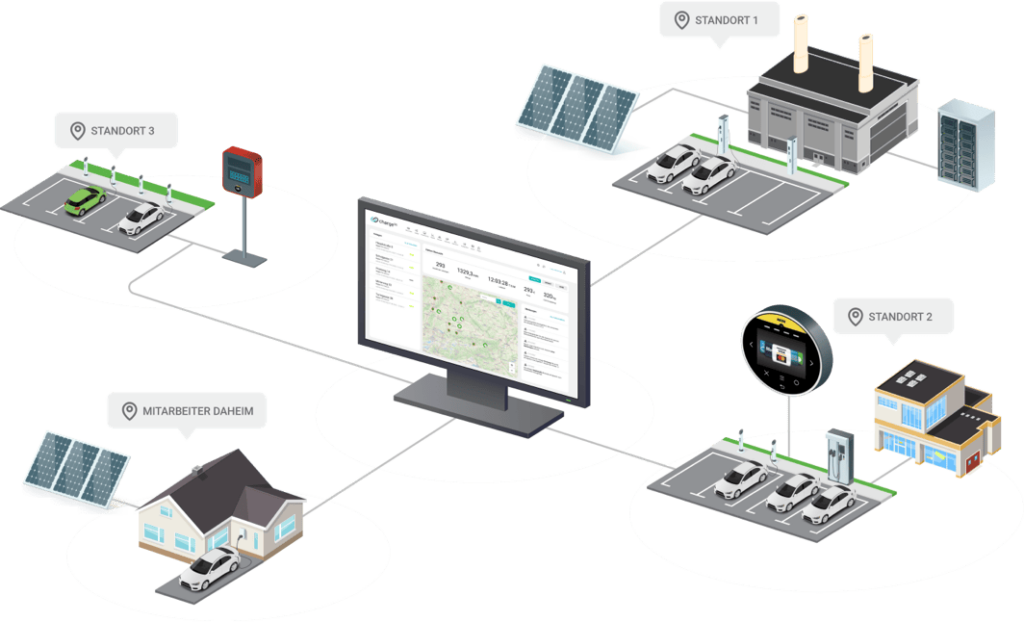

Monitoring - a simple introduction to energy management
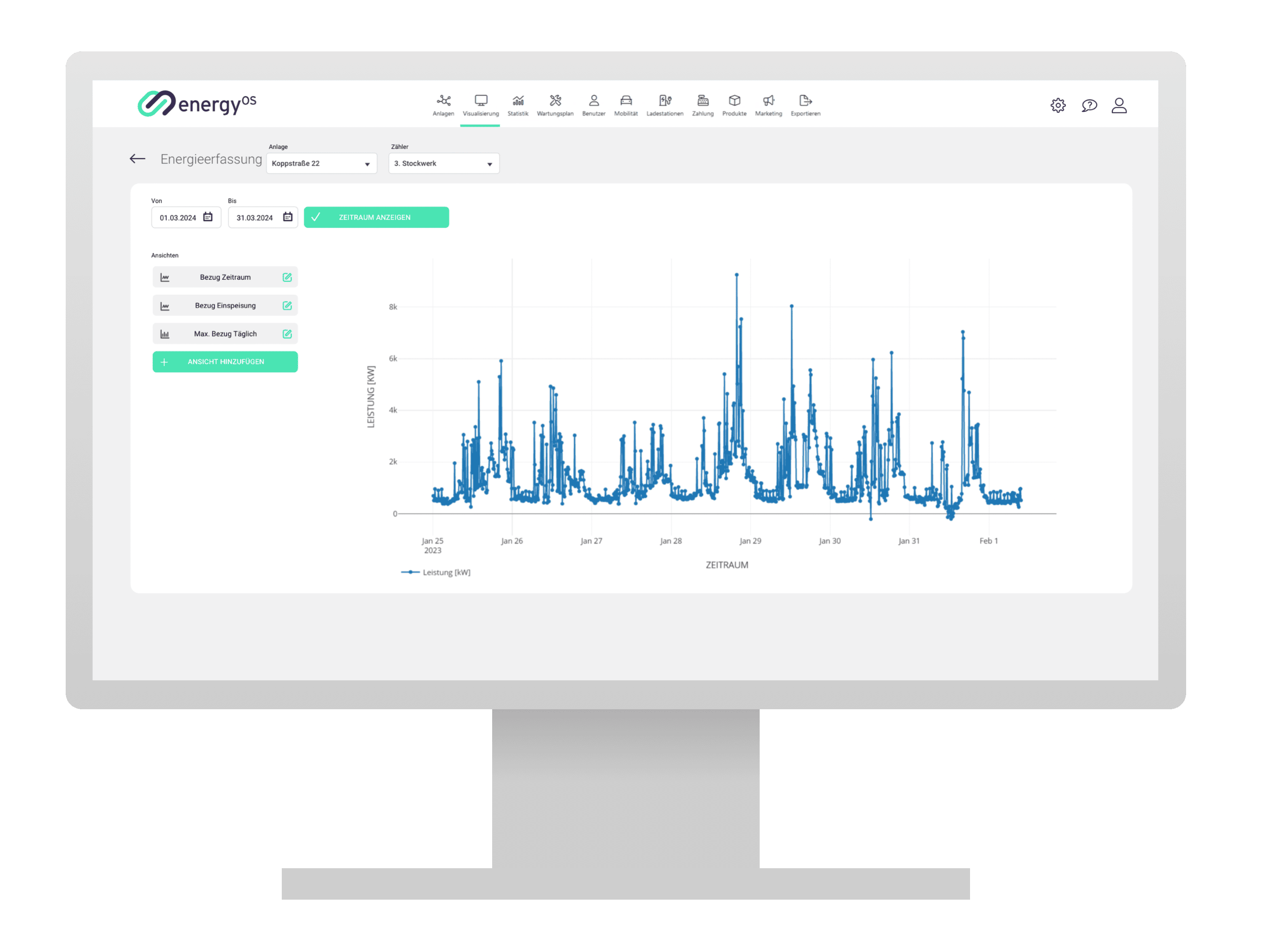
The first step is to record energy data. To do this, the signal is recorded by different sensors depending on the energy source - in the case of electricity, for example, folding transformers are attached to the cables and connected to the measurement and control hardware. From there, the signal is sent on to our software, which records these data points second by second, visualizes them and processes them for further steps in consumption optimization.
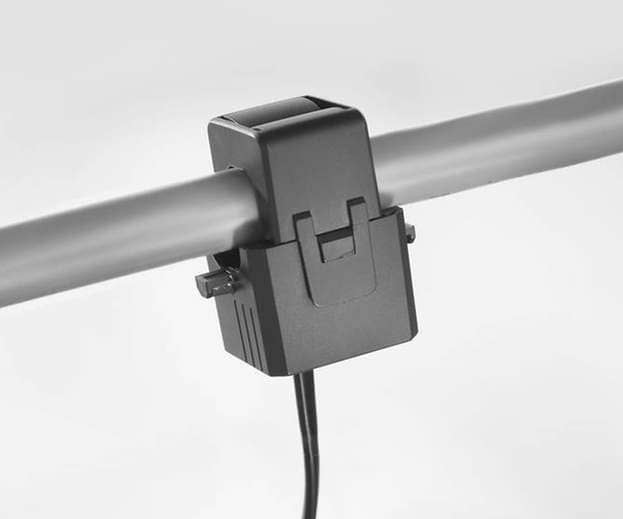
Attach the hinged transformer to the power cable and connect it to the control unit - that's how easy it is to record and visualize energy data.
Load profile
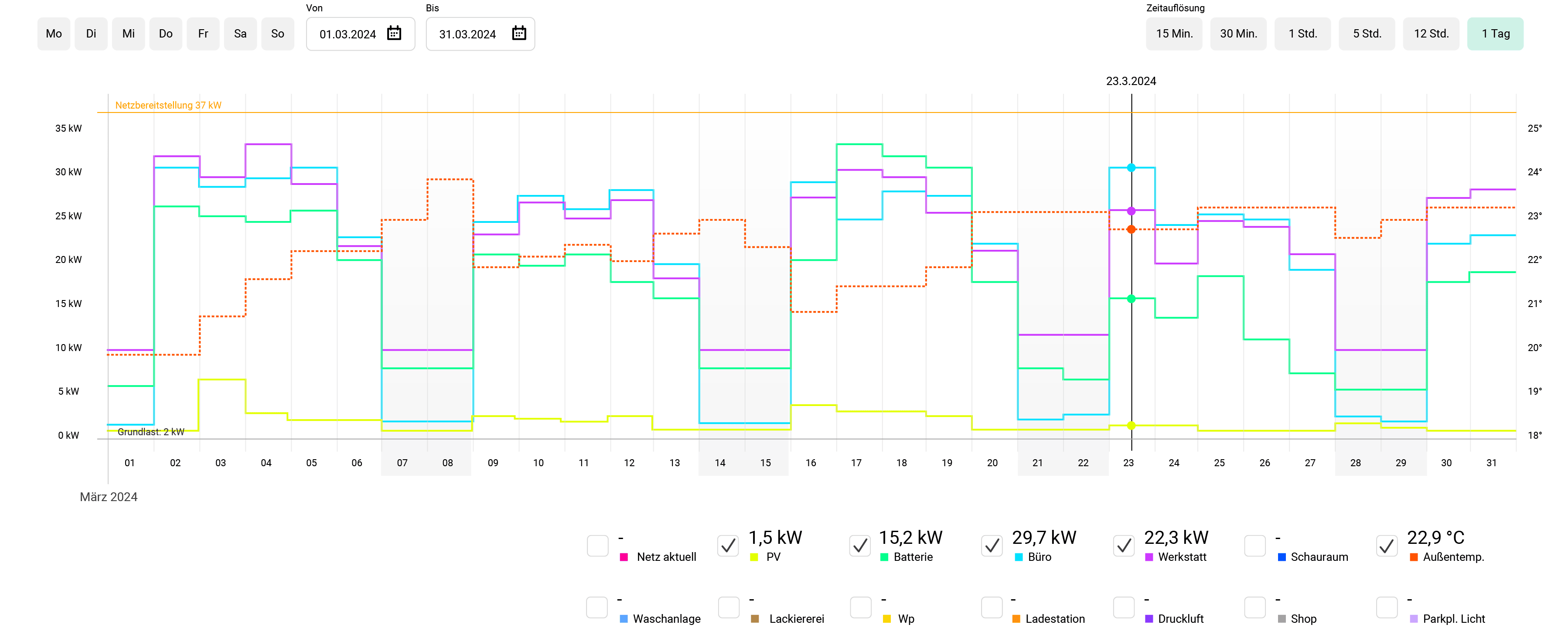
Data points from various sources of energy consumption are recorded every second and visualized as a curve. This data is used to create load profiles for the desired time frame at the touch of a button - for individual appliances as well as the entire system. The profiles serve as a basis for identifying optimization potential and are also the basis for connecting to the spot and balancing energy market.

Modular solution for energy management
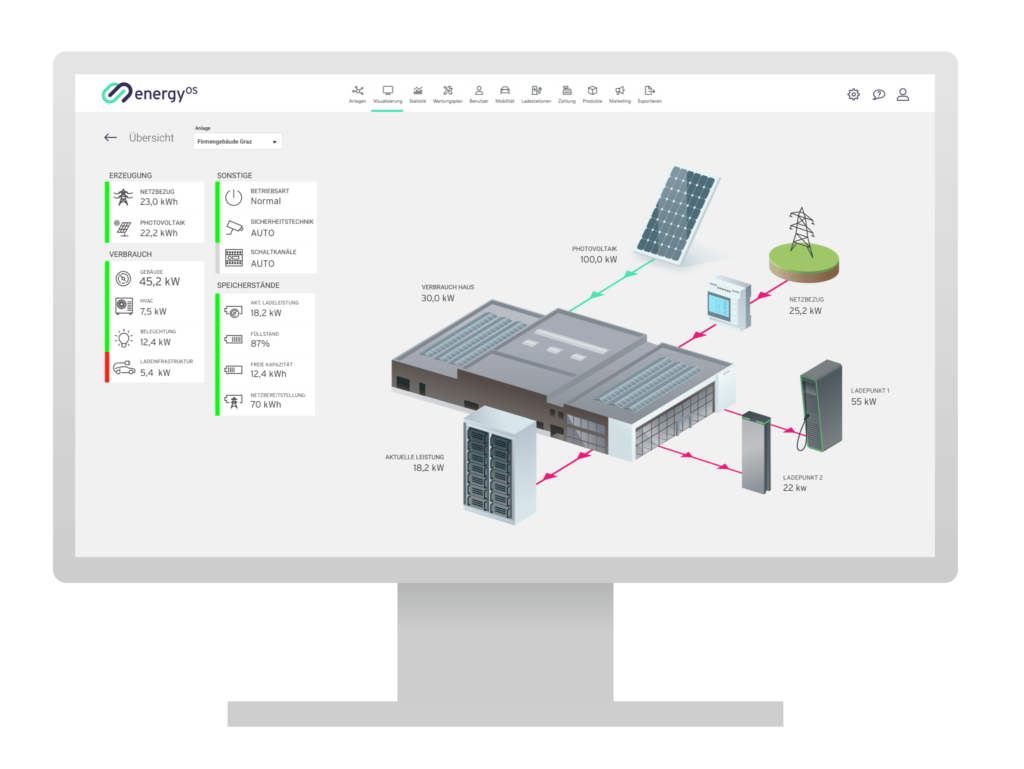
Using the experience gained from the load profile, energy potential can be identified and the system can be made more efficient accordingly. This can be achieved, for example, by reducing the base load, which can save thousands of euros per year. In addition, intelligent load distribution makes it possible to regulate the energy flow. If necessary, the charging power of charging stations can be reduced or energy storage systems can be added to avoid peak loads.
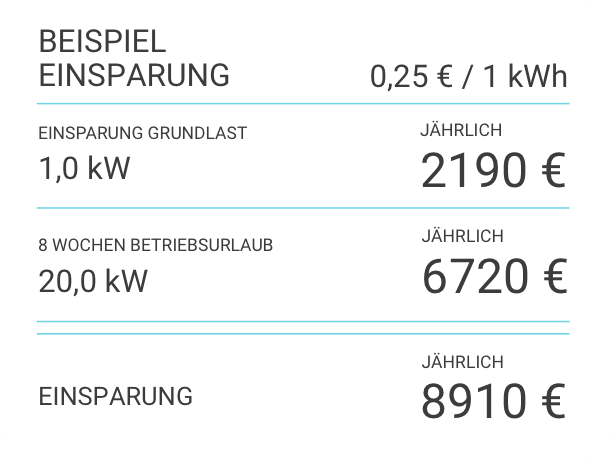
Further features and functions from energyBOSS
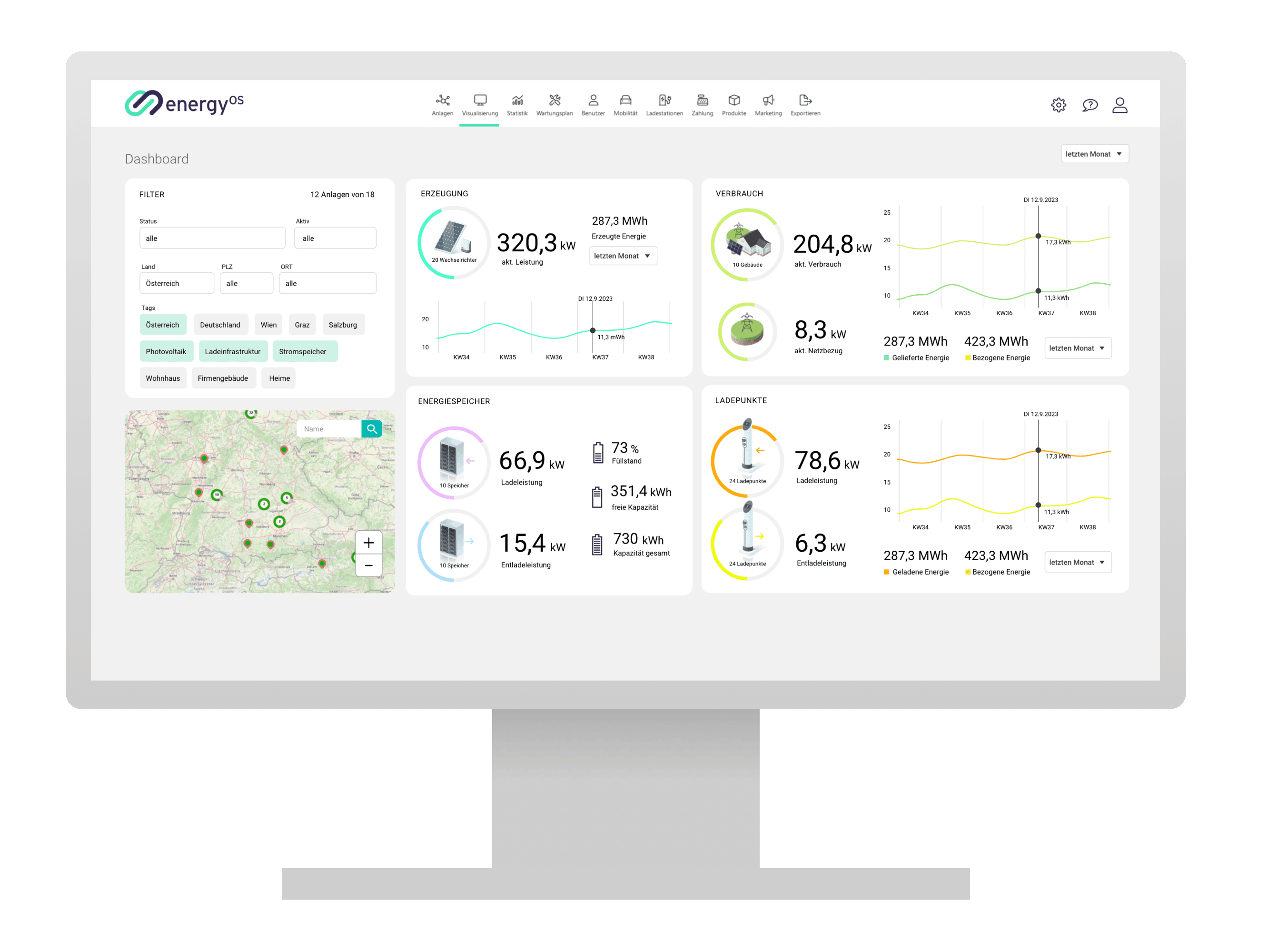
Everything at a glance
The dashboard gives you a complete overview of all your systems and energy values. The system values can be displayed selectively as required using the filter function. The dashboard also functions as the starting point for more detailed views of the system, allowing you to switch directly to storage or charging management with a single click, for example. The displayed areas are compiled into a modular overview depending on the system and customer requirements.
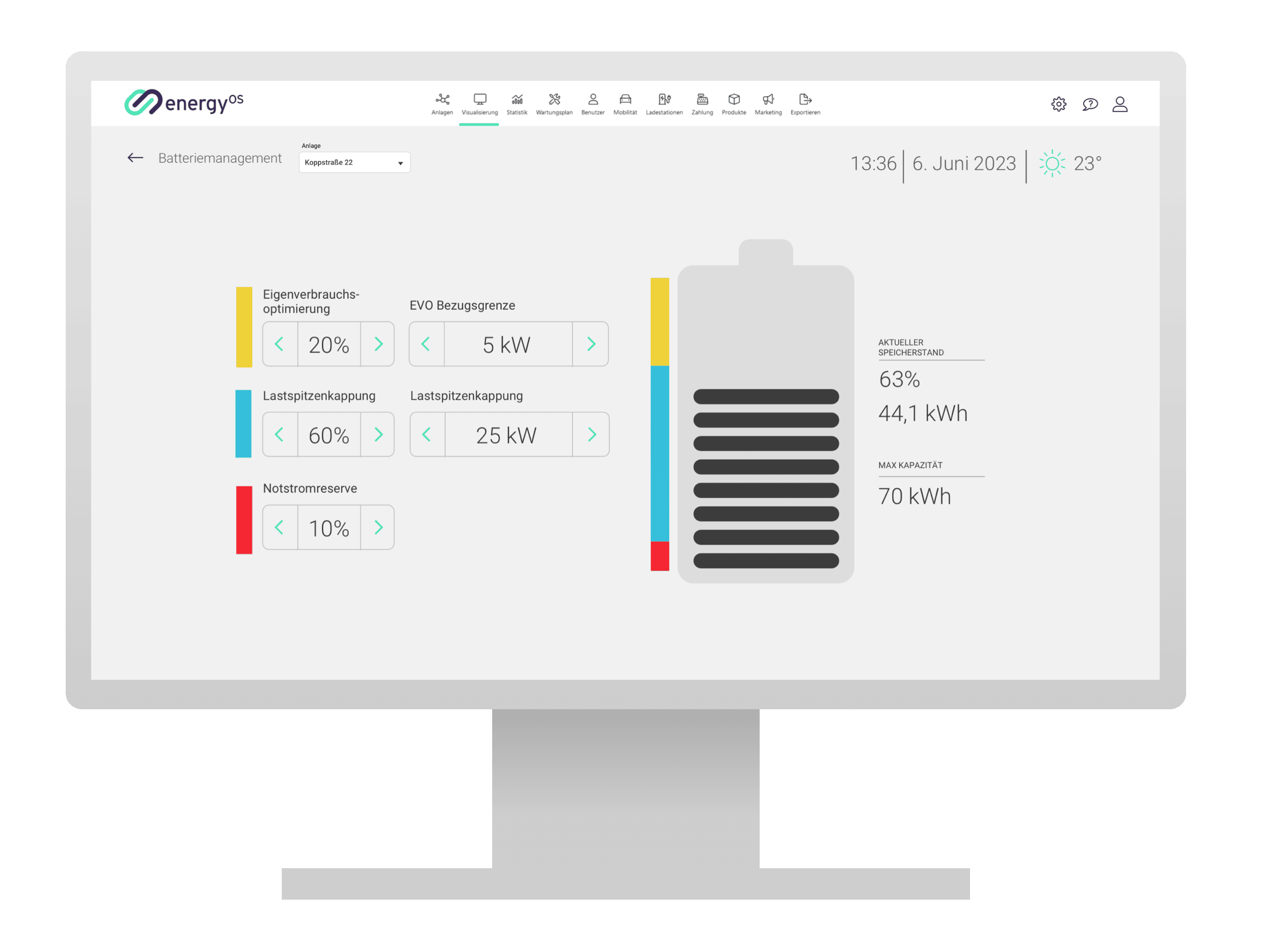
Seamlessly integrated storage management
Storage management uses suitable strategies and technical and organizational measures to optimize the efficiency and performance of the storage systems used in a company, such as electricity, heat, cooling, compressed air and hydrogen storage. The aim is to optimally distribute energy to the various storage systems, taking into account the different requirements.
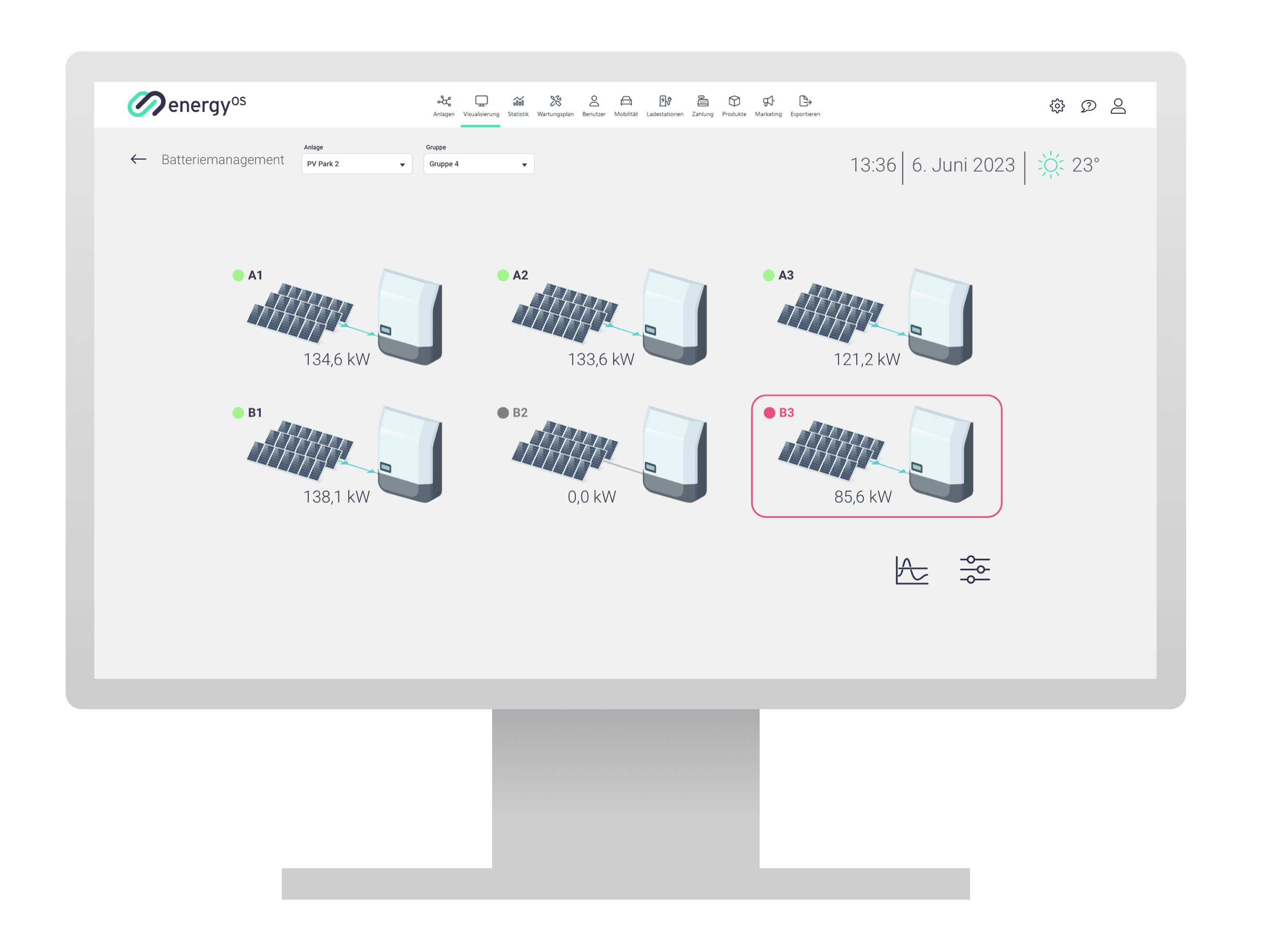
Monitoring of photovoltaic power plants and large-scale systems
Thanks to its scalability, the entire system and its user interface is suitable for systems of any size and enables the monitoring of predefined parts as well as the system as a whole. It records all relevant data from hundreds of PV panels, inverters and sun trackers, which are all displayed centrally for a perfect overview. This data is also used for predictive maintenance for the early detection of defective panels.
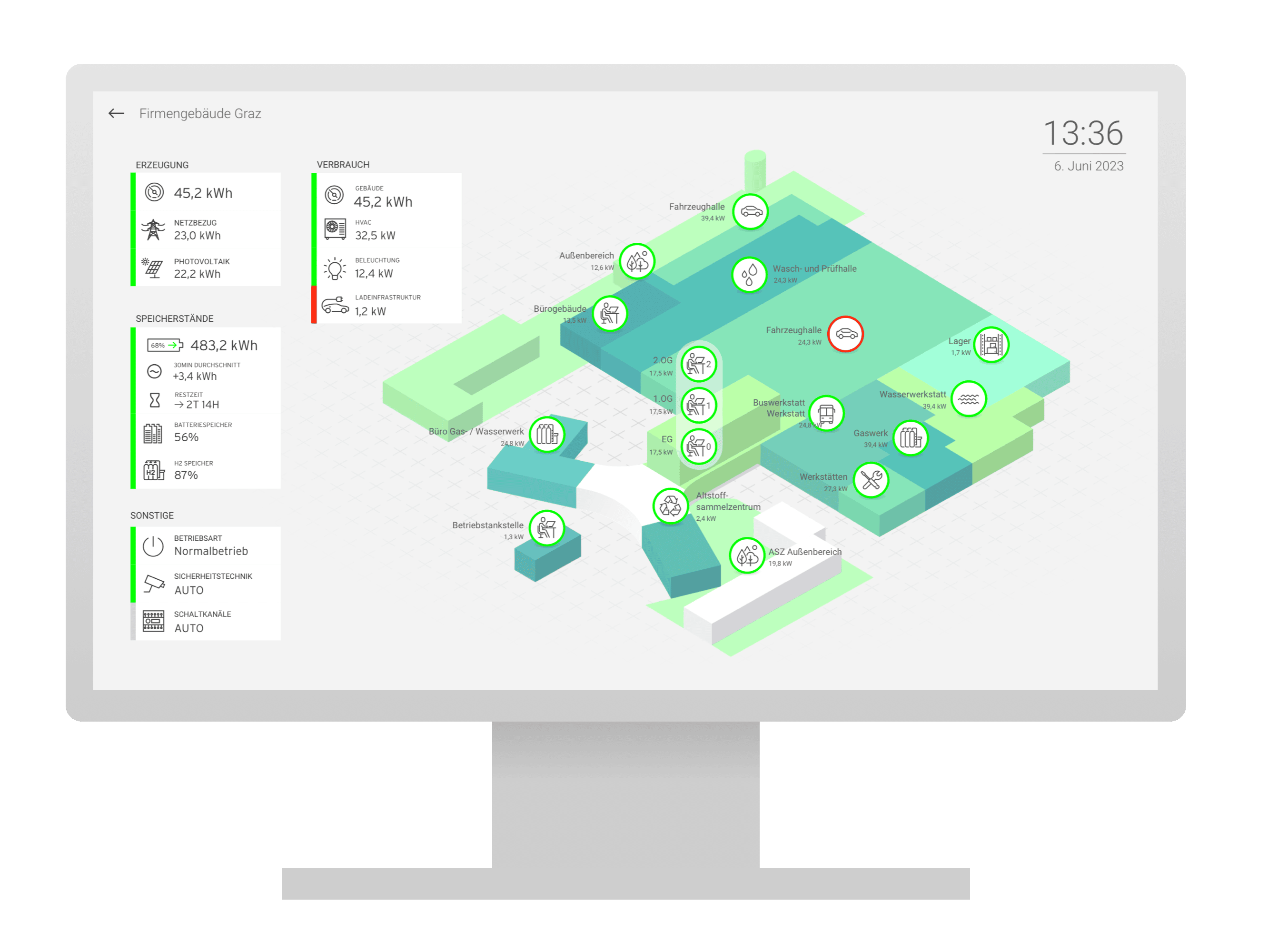
Blackout and emergency power management for critical infrastructure
In the event of a blackout, the manager has an overview of the entire system at all times and can see how long the available power will last. Based on this information, he can make the necessary decisions and switch the power supply to the individual areas on and off. The entire emergency power management system runs locally and therefore functions independently of the internet connection.
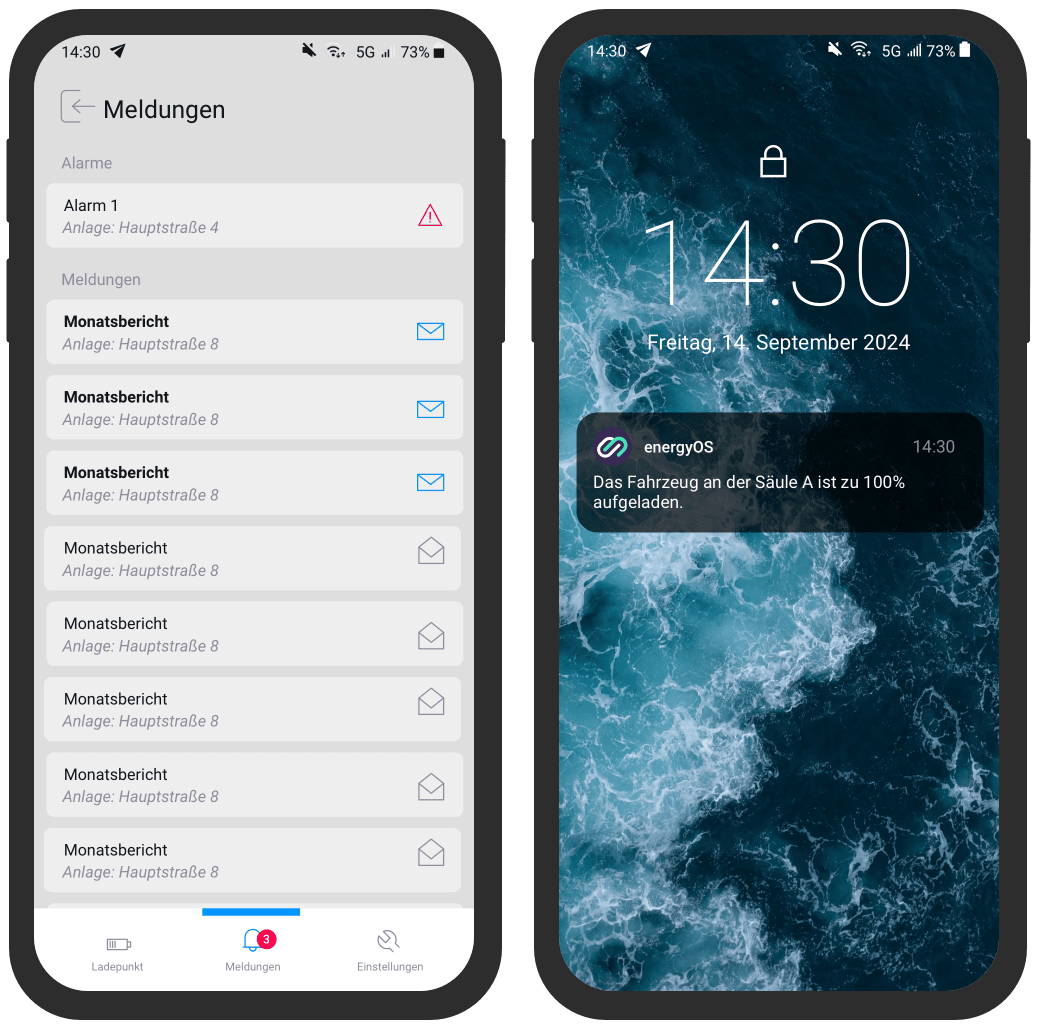
Alerts and notifications
In the event of changes or notable events such as exceeding or falling below limit values, updates, etc., energyOS sends notifications to users via several channels such as email, SMS or push notifications from the mobile app. The different warning levels are defined in the settings and can be assigned depending on the area of competence and authorization in the user administration.
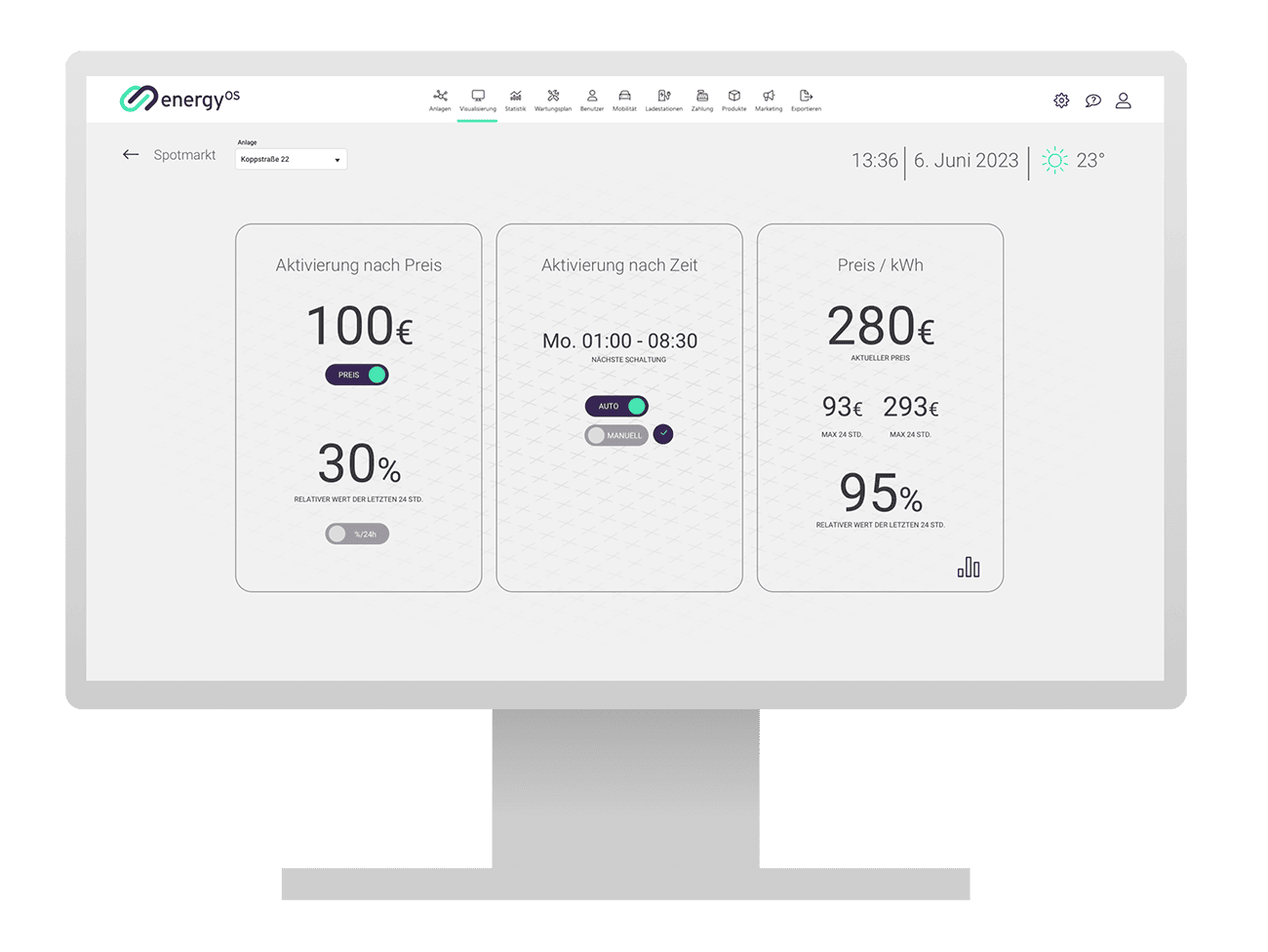
Connection to power exchanges
energyOS offers a direct connection to the spot and balancing energy market, allowing you to set the desired electricity price or a percentage of the current maximum 24-hour value via the user interface. In this way, energy can also be automatically drawn from these sources via energyOS when the optimum conditions prevail on the market. Optionally, the purchase can also be activated by time switching based on the load profile analysis.
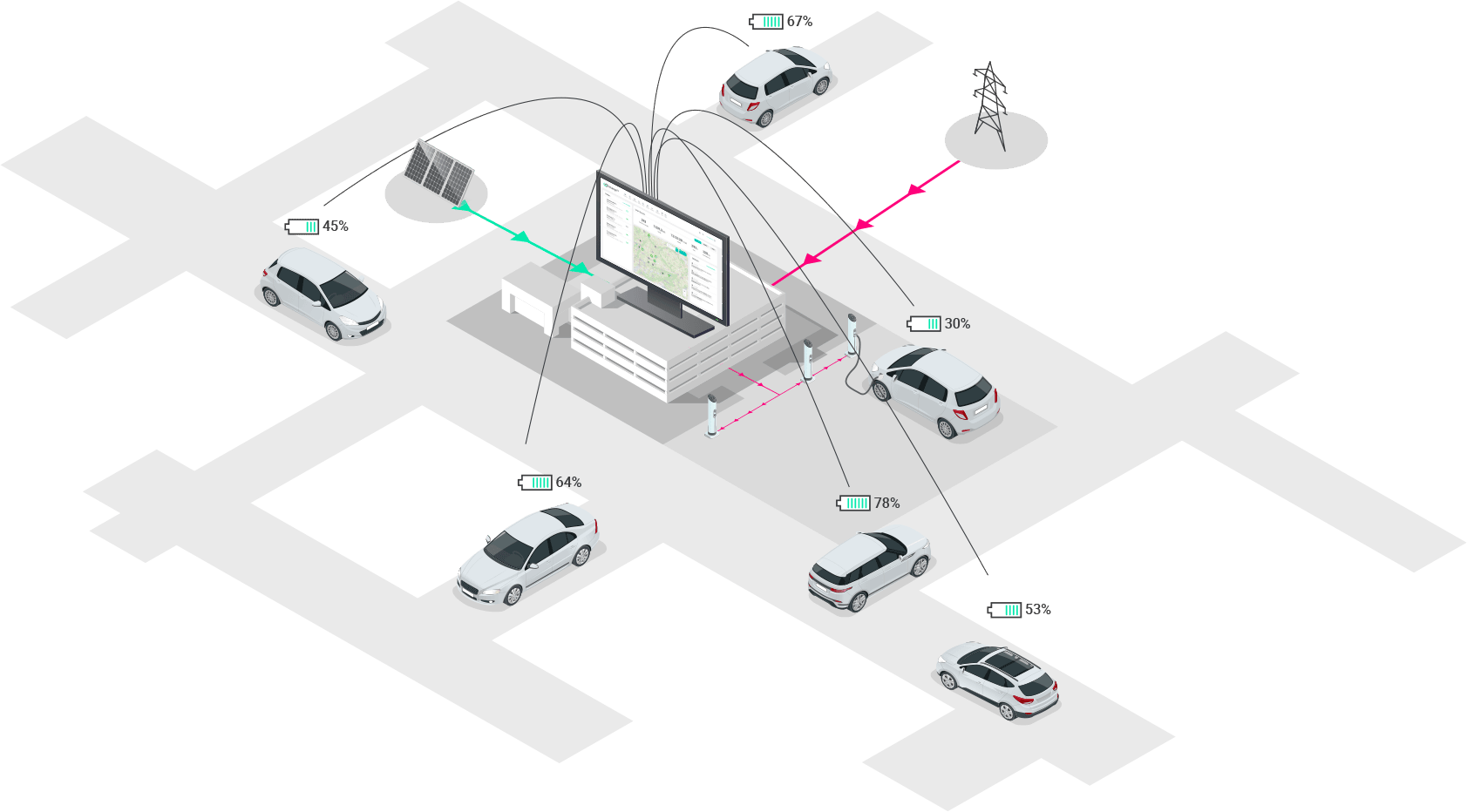
Fleet storage management
The battery levels of all vehicles in the fleet are recorded and combined into one system. This enables energy management to generate energy in advance, store it or buy it cheaply and recharge the fleet efficiently.
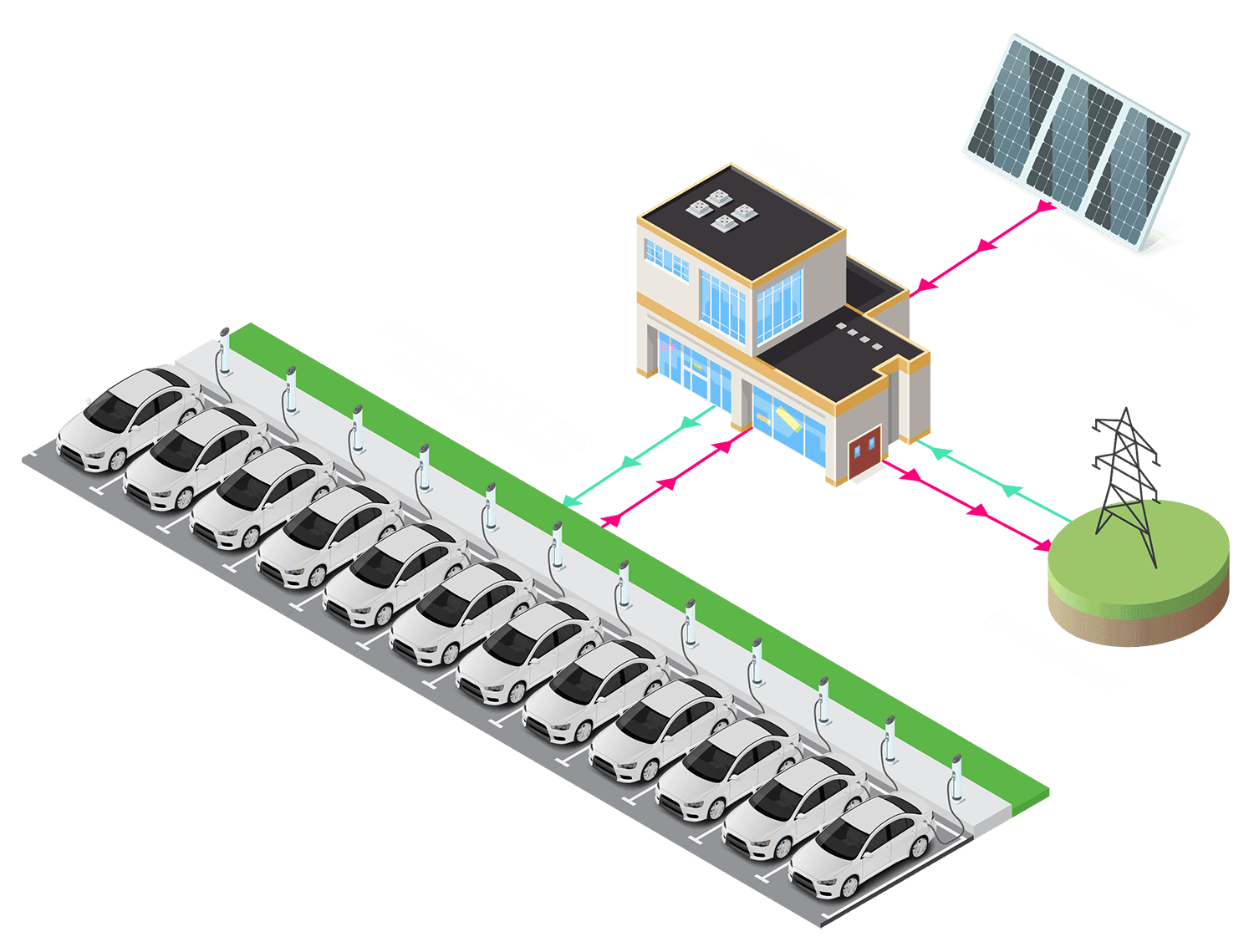
E-fleet as electricity storage
The bidirectional charging and use of electric cars for storing electricity can be an important part of energy management and consumption optimization. Not only can electric cars be charged, they can also be used to store electricity. Cheap, surplus electricity can be stored in car batteries and released again when needed. In this way, energy efficiency can be increased and the cost of electricity consumption reduced.
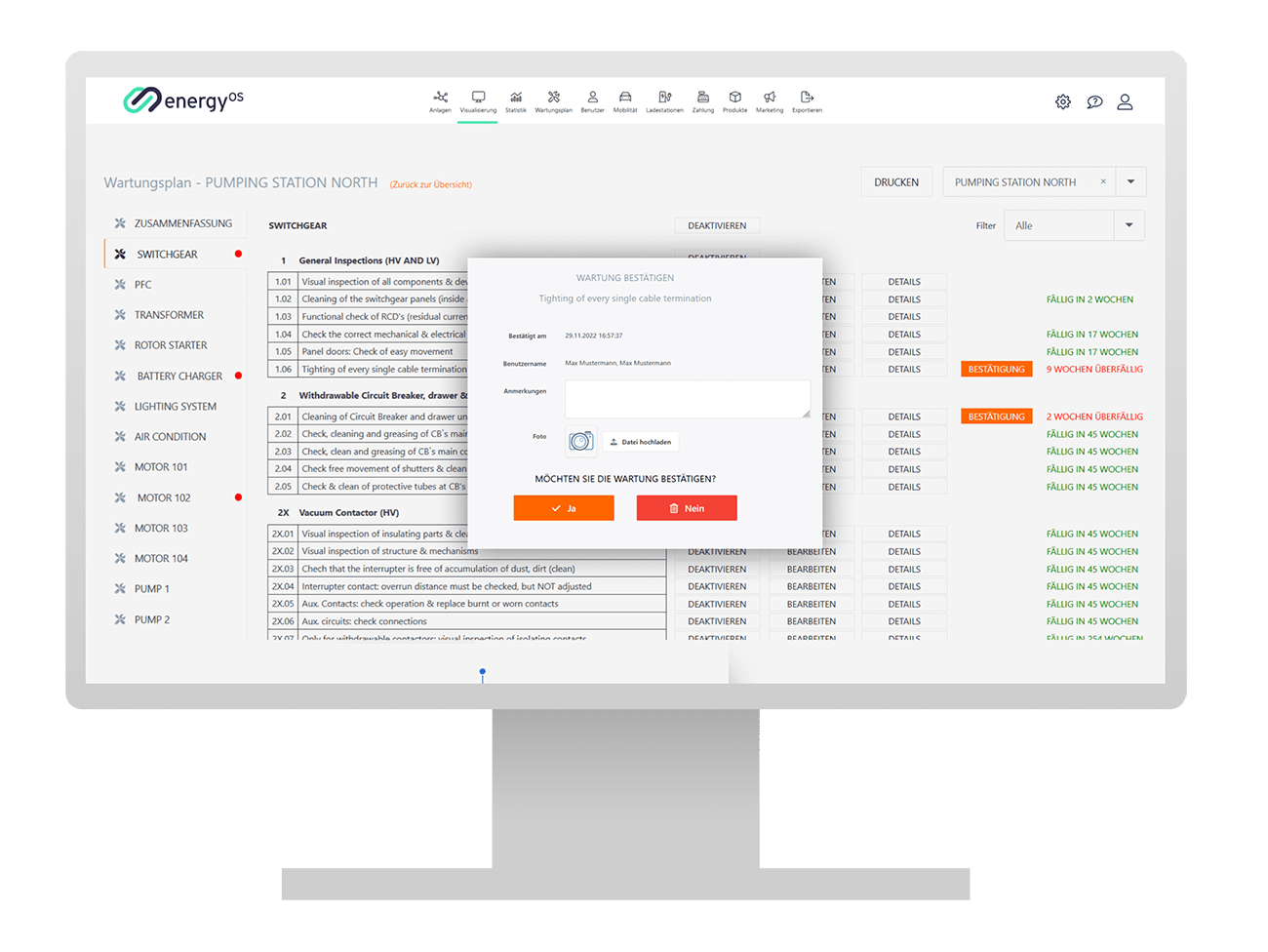
Record upcoming maintenance and document
With energyOS, maintenance plans are recorded and maintenance logs are generated automatically. The system also enables recurring inspections to be scheduled and has integrated defect documentation.
 |
Everything at a glanceThe dashboard gives you a complete overview of all your systems and energy values. The system values can be displayed selectively as required using the filter function. The dashboard also functions as the starting point for more detailed views of the system, allowing you to switch directly to storage or charging management with a single click, for example. The displayed areas are compiled into a modular overview depending on the system and customer requirements. |
 |
Seamlessly integrated storage managementStorage management uses suitable strategies and technical and organizational measures to optimize the efficiency and performance of the storage systems used in a company, such as electricity, heat, cooling, compressed air and hydrogen storage. The aim is to optimally distribute energy to the various storage systems, taking into account the different requirements. |
 |
Monitoring of photovoltaic power plants and large-scale systemsThanks to its scalability, the entire system and its user interface is suitable for systems of any size and enables the monitoring of predefined parts as well as the system as a whole. It records all relevant data from hundreds of PV panels, inverters and sun trackers, which are all displayed centrally for a perfect overview. This data is also used for predictive maintenance for the early detection of defective panels. |
 |
Blackout and emergency power management for critical infrastructureIn the event of a blackout, the manager has an overview of the entire system at all times and can see how long the available power will last. Based on this information, he can make the necessary decisions and switch the power supply to the individual areas on and off. The entire emergency power management system runs locally and therefore functions independently of the internet connection. |
 |
Alerts and notificationsIn the event of changes or notable events such as exceeding or falling below limit values, updates, etc., energyOS sends notifications to users via several channels such as email, SMS or push notifications from the mobile app. The different warning levels are defined in the settings and can be assigned depending on the area of competence and authorization in the user administration. |
 |
Connection to power exchangesenergyOS offers a direct connection to the spot and balancing energy market. The desired electricity price or a percentage of the current maximum 24-hour value can be set via the user interface. In this way, energy can also be automatically drawn from these sources via energyOS when the optimum conditions prevail on the market. Optionally, the purchase can also be activated by time switching based on the load profile analysis. |
 |
Fleet storage managementThe battery levels of all vehicles in the fleet are recorded and combined into one system. This enables energy management to generate energy in advance, store it or buy it cheaply and recharge the fleet efficiently. |
 |
E-fleet as electricity storageThe bidirectional charging and use of electric cars for storing electricity can be an important part of energy management and consumption optimization. Not only can electric cars be charged, they can also be used to store electricity. Cheap, surplus electricity can be stored in car batteries and released again when needed. In this way, energy efficiency can be increased and the cost of electricity consumption reduced. |
 |
Record upcoming maintenance and documentWith energyOS, maintenance plans are recorded and maintenance logs are generated automatically. The system also enables recurring inspections to be scheduled and has integrated defect documentation. |
energyOS offer
In our offer, we make a fundamental distinction between monitoring (recording energy data and monitoring the systems) and energy management (control and consumption optimization based on the data obtained through monitoring). Our offer includes the necessary hardware and software. Monitoring can be extended to the management system without additional hardware.

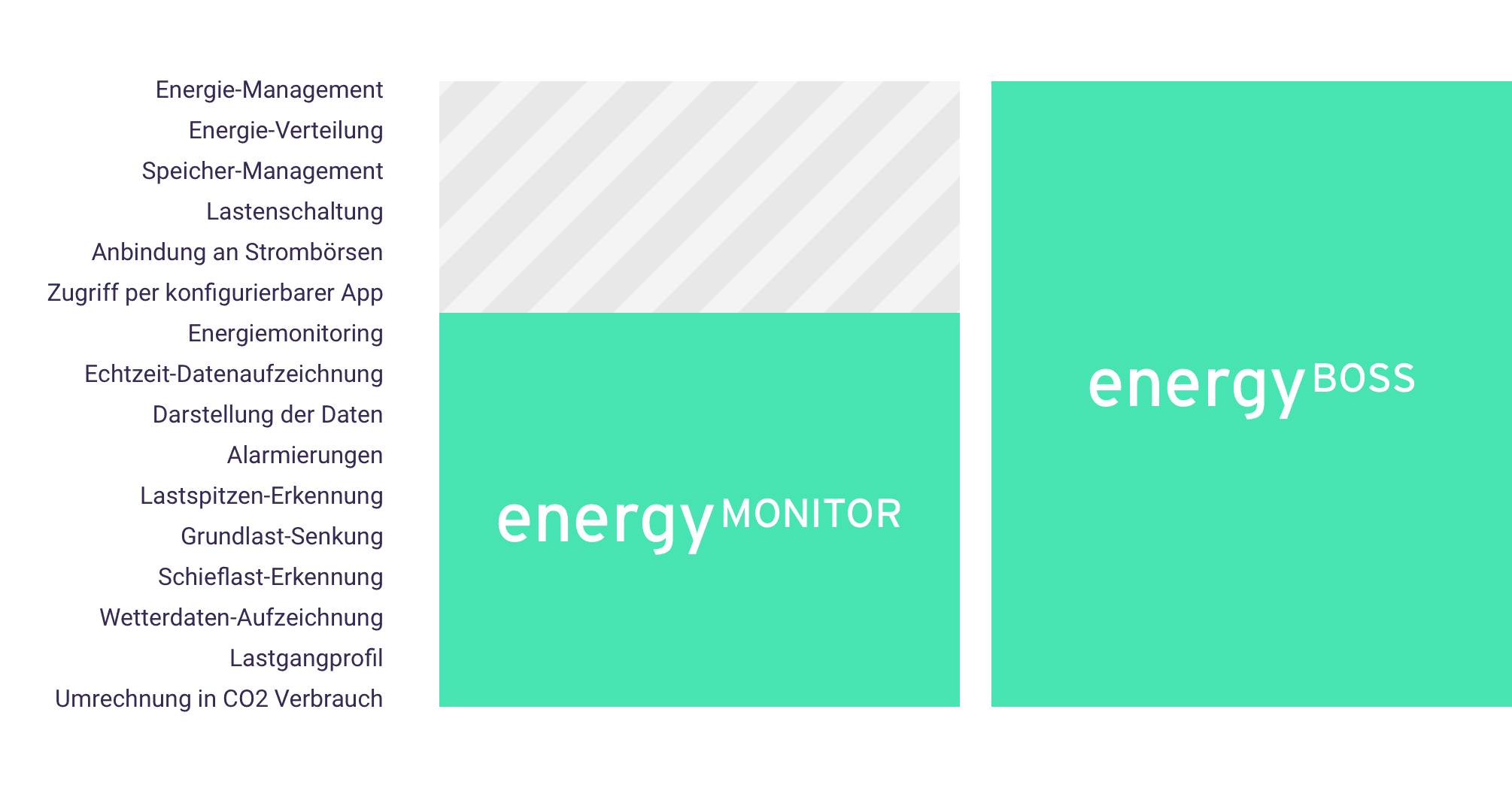
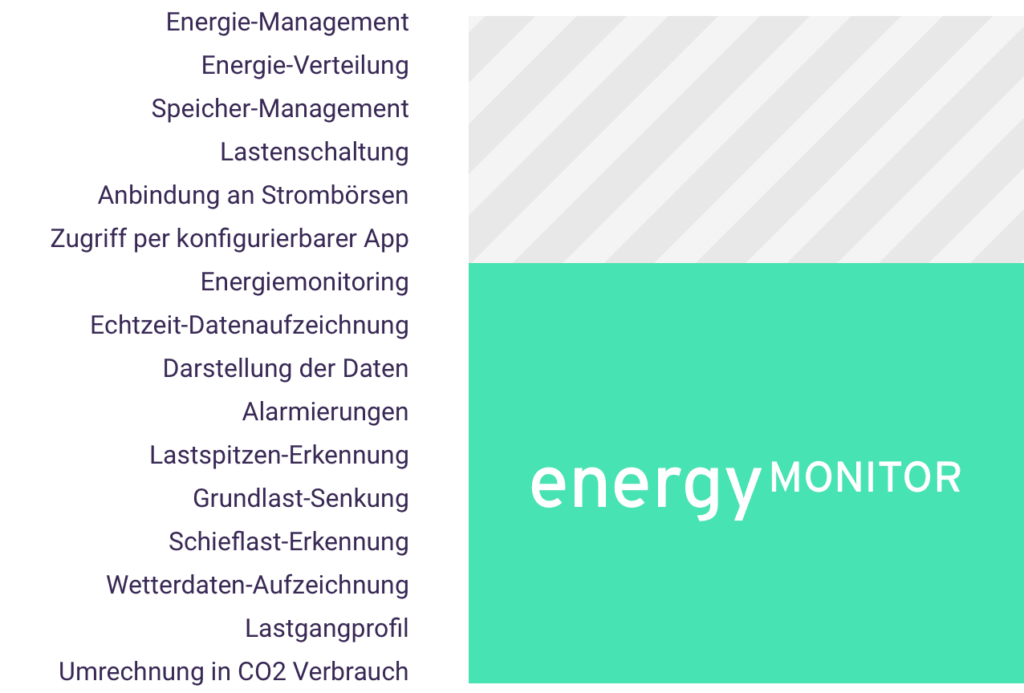
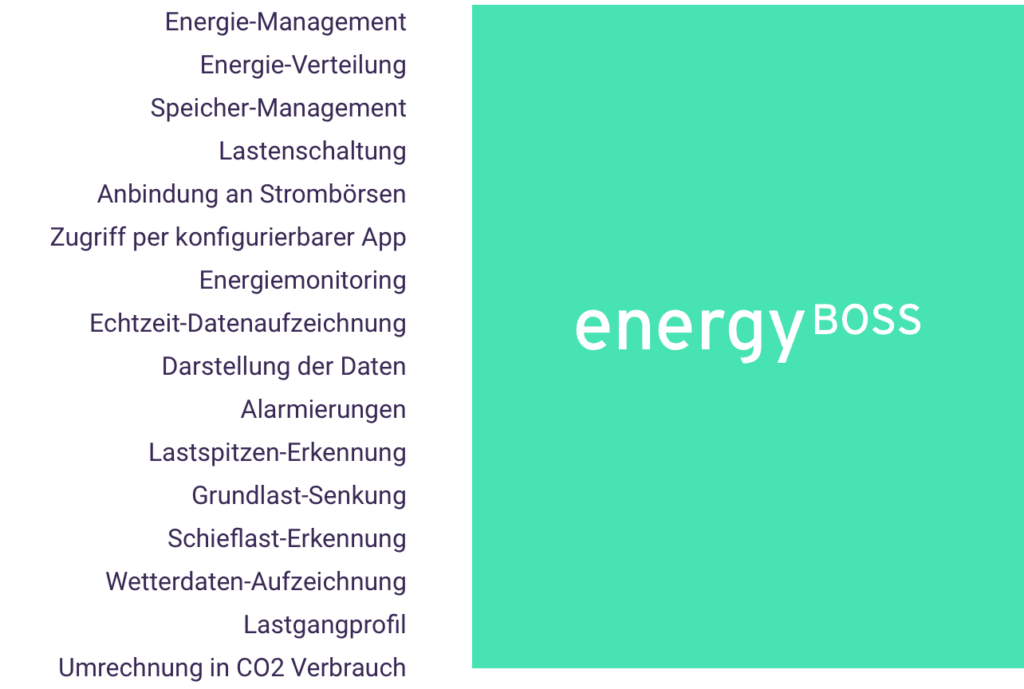
Required hardware
As our software is manufacturer-independent, you are free to choose your hardware according to your individual requirements. We will be happy to advise you on the selection of suitable control and measurement hardware.
Controller
The controller is the brain of the control system. This is where all data is processed and instructions are sent to the system and data from monitoring is processed.
Counter
This module is used for 1-phase / 3-phase power and energy metering. It supports bidirectional operation up to 80A.
Relay extension
The relay extension is the switch that executes the commands from the controller directly. It is therefore only used in conjunction with the energyBOSS.
Bus coupler
The bus coupler is used for decentralized measurement. With this module, measurement data can also be sent to the controller without a cable connection.
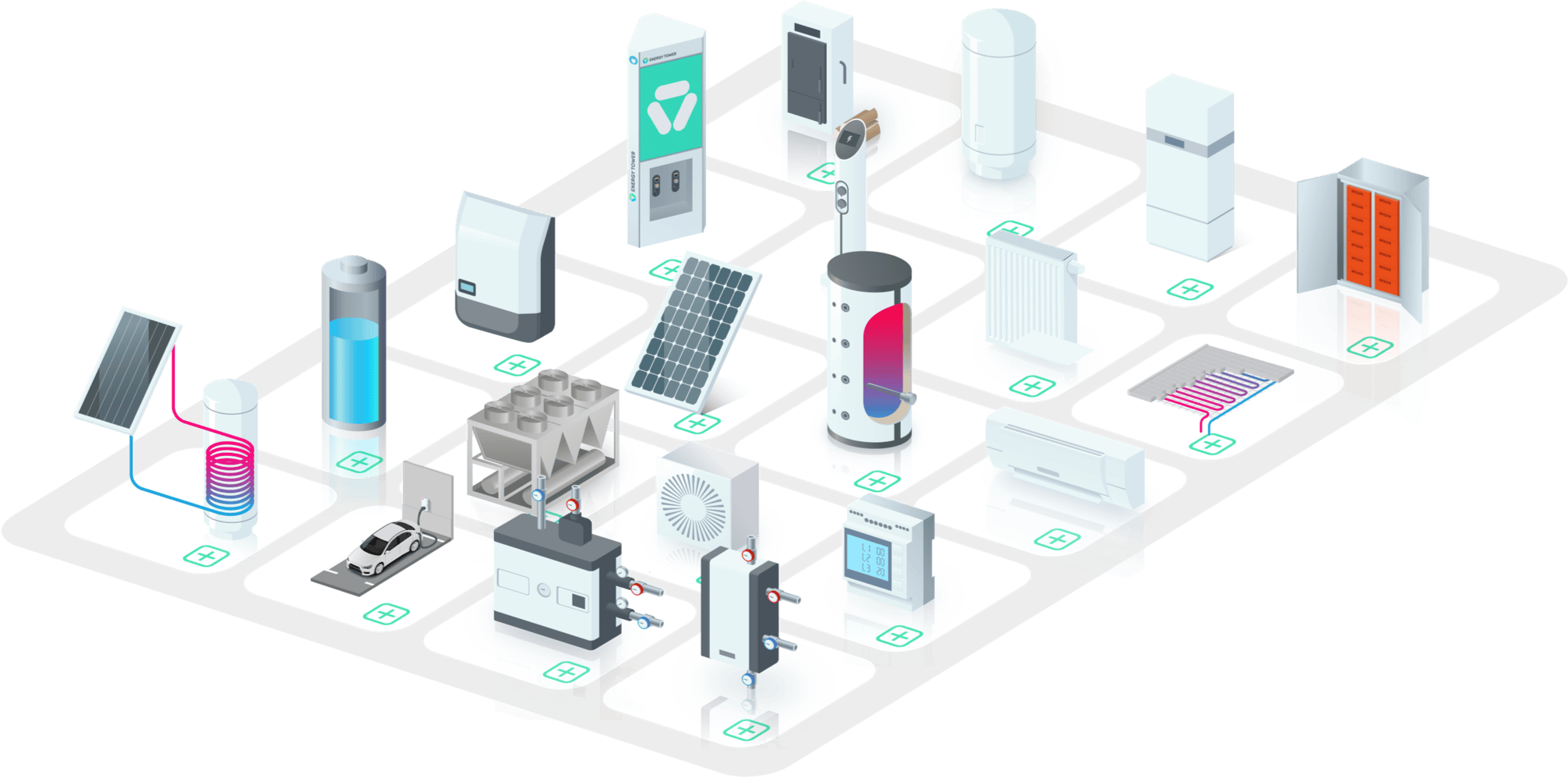
Reisenbauer Platform
Our experience spans a wide range of applications and industries, thanks to our proprietary platform which is completely hardware-independent and allows solutions for every conceivable scale. Our software ecosystem offers a high degree of flexibility, which ensures short implementation times,
reliability, and, above all, security.
Your contact persons

Stephen Löwenstein

Siegfried Muhr
Reisenbauer Solutions GmbH
Handelskai 265 / TOP 328
1020 Vienna
office@reisenbauer.solutions
+43 1 276 2698
Handelskai 265 / TOP 328
1020 Vienna
office@reisenbauer.solutions
+43 1 276 2698
To get the latest information, you can follow us on our social media channels or subscribe to our mailing list.



